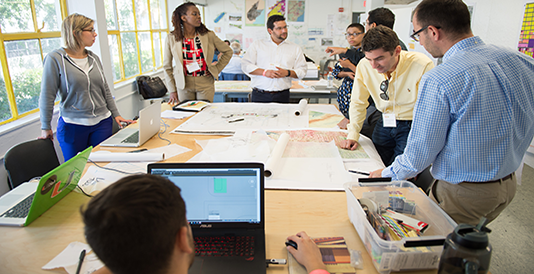 November 28, 2016 (Source: Nancy Schneider, Southeast Florida Regional Climate Change Compact) - Engaged. Dedicated. Involved. These three words describe all who participated in the Southeast Florida Regional Climate Change Compact’s Resilient Redesign III on November 14-17 at the University of Miami, School of Architecture. Professionals and experts who came from the private sector, academia, and NGOs, as well as students from University of Miami and Florida Atlantic University, all volunteered their time to collaborate with public sector practitioners on addressing the challenges in three areas of Southeast Florida: Arch Creek (Miami-Dade County), Shorecrest (City of Miami) and Lower Matecumbe Key (Village of Islamorada).
November 28, 2016 (Source: Nancy Schneider, Southeast Florida Regional Climate Change Compact) - Engaged. Dedicated. Involved. These three words describe all who participated in the Southeast Florida Regional Climate Change Compact’s Resilient Redesign III on November 14-17 at the University of Miami, School of Architecture. Professionals and experts who came from the private sector, academia, and NGOs, as well as students from University of Miami and Florida Atlantic University, all volunteered their time to collaborate with public sector practitioners on addressing the challenges in three areas of Southeast Florida: Arch Creek (Miami-Dade County), Shorecrest (City of Miami) and Lower Matecumbe Key (Village of Islamorada).
Resilient Redesign began in 2014 when the Dutch Consulate approached the Southeast Florida Regional Climate Change Compact to hold a design charrette addressing the challenges in Southeast Florida related to flooding caused by sea level rise, high(er) tides, and extreme rain events. In the Netherlands, a country where 26% of land area is below sea level and 50% is three feet elevation or less, they have perfected “living with water” over the centuries. This four-day event began with participants donning their flip flops or rubber boots and wading through the brackish water on the tour of the affected areas, which coincided with a King Tide causing the streets to look more like canals. Due to high levels of water on many streets, city services were interrupted, residents were cut off from driving out of their driveways or from taking their usual routes. The teams reunited on the second day to begin discussions on what could be done through design to address flooding, overstressed infrastructure, improve residents’ quality of life, and improve economic opportunities. The teams worked late into the nights, developing ideas with input from experts in hydrology, land use law, infrastructure and natural systems.
In addition to living with water, all teams had a second theme: integrating nature and natural systems into the designs. Unfortunately in the past, nature was considered something to be bulldozed over and forced to disappear with development in Florida. Much of this is what is causing the problems today with developed tracts in what was once wetlands or riverbeds.To allow for greater resiliency over time, charrette leader Sonia Chao, director of the university’s Center for Urban and Community Design, advised designs for the short-term, mid-term and long-term. This helps ensure that short-term solutions don’t get in the way of the mid-term, and similarly for the mid-term considerations to not inhibit the long-term goals. By incorporating legal options into the design choices, short-term considerations become more feasible and creating the opportunity for long-term natural systems solutions.











